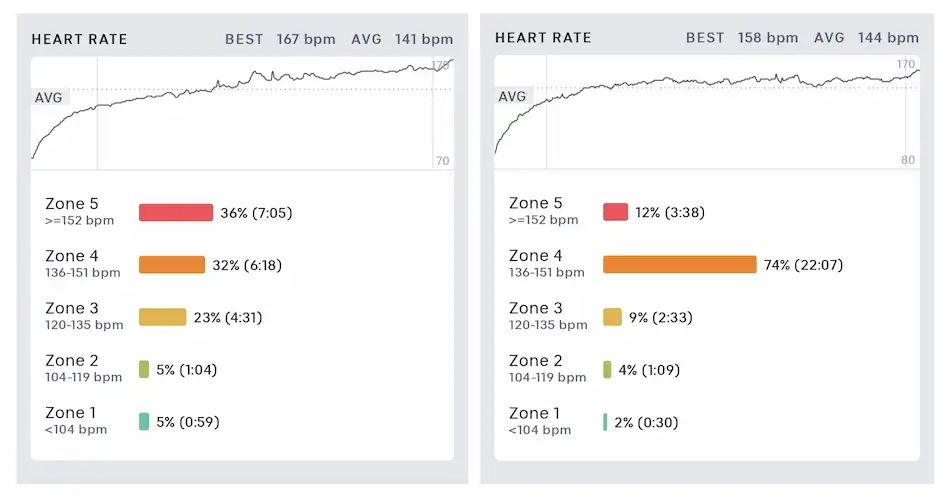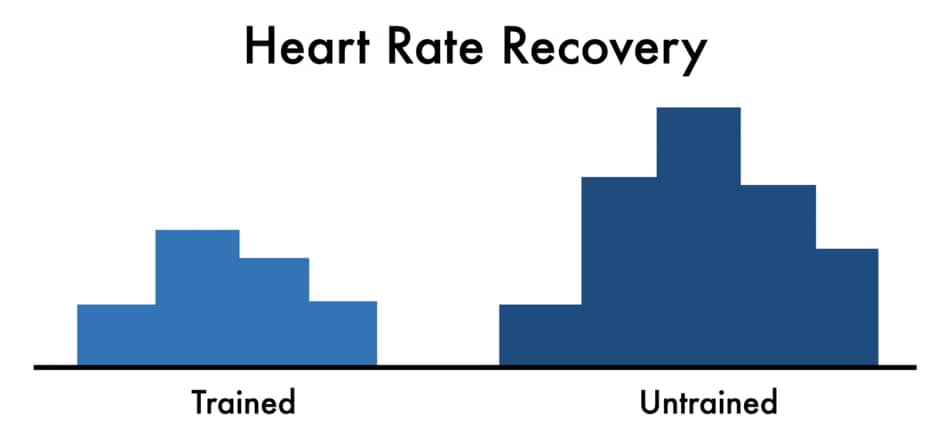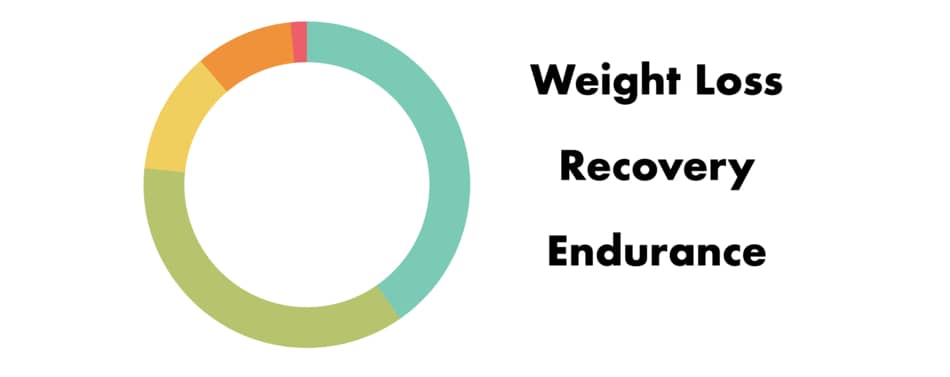I’ve been experimenting with the peloton strive score for the last month (it’s been insane but in a good way).
Today I want to share with you some of the cool things you can do with your strive score metrics, and how to use them to analyze your performance.

What is the Peloton strive score?
Peloton added a new feature called ‘strive score’ that allows you to measure your wokrout intensity (and I think I become slowly obsessed with it).
A strive score gives you (you guessed it) a score that is calculated based on your heart rate and the time you spend exercising in each of the heart rate zones.
You don’t have to turn on the peloton strive score, or make any changes to your profile (it’s all done and ready to go).
Strive score is personal
“The peloton strive score is a personal metric used to calculate your workout intensity levels, especially during the classes when you’re off the bike like bootcamp, strength, yoga, or HIIT,” says former CEO of Peloton Interactive, John Foley.
“Before the peloton introduced strive score, there was no way to quantify your performance or intensity from these workouts,” explains John.
The bike has a built-in power sensor so you can track your average output, cadence, and more.
“When you’re off the bike, the only way to ‘measure’ how hard your train was via traditional how-it-feels scale like RPE (rated perceived exertion),” says John.
Strive score gives you more information

For me, the strive score is all about data. Now I can not only track my intensity but also compare my results with my previous workouts and measure progress.
Peloton strive score is not an output
The difference between the peloton strive score and output is simple.
Power output is calculated directly from the bike via a power sensor.
For instance, your bike remembers every ride and will record the amount of kJ and watts that you generated. It will also estimate your FTP score, and even calories burned.
The peloton strive score is calculated based on the formula that uses maximum heart rate via the heart rate monitor that you should be wearing.
(Yes, strive score won’t record anything if you don’t have an apple watch or other heart rate monitor.)
Strive score is less accurate than the power sensor
If you like to measure your intensity (on the bike), I would recommend doing power training with peloton power zones, not the heart rate zone.
Why?
The power sensor on the bike is more accurate to track the intensity, according to Jeroen Swart, Ph.D., a director of the sports medicine academic program at the University of Cape Town.
“Power output is a more direct measure of workload, whereas heart rate responds relatively slow to changes in exercise intensity,” says Dr. Swart.
For example, when you sprint for 20 seconds, followed by 2 minutes recovery period, the heart rate monitor will register changes in the heartbeat after you finish the sprint, not during.
This is often called “heart rate lag time” (around 30 seconds), which is a delay between the actual onset of activity and your heart rate.
However, when you’re off the bike, the strive score can provide you with more accurate data.
How does the Peloton strive score work?
The peloton strive score works by giving you points (based on your effort level).
For instance:
- you recevie 0.3 points for every minute that you spend in the heart rate zone 1; and
- for the heart rate zones 2, 3, 4, and 5 the peloton multiplies the score by 2, 4, and 8 respectively.
Peloton strive score range
Below you can see the table of the peloton heart rate zones and the corresponding strive score multiplier.
| Peloton Heart Rate Zones | Strive Score Multiplier |
|---|---|
| Zone 1 | 1 |
| Zone 2 | 2 |
| Zone 3 | 4 |
| Zone 4 | 8 |
| Zone 5 | 8 |
How is the peloton strive score calculated?
The peloton strive score is calculated based on the generalized equation for maximal heart rate (220 – age), in accordance to the CDC guidelines.
The peloton calculates the heart rate zones and assigns the strive score based on the minutes you spend at a certain heart rate.
(There are some limitations to this formula, which I will talk about in a moment.)
Below you can see the table of peloton heart rate zones based on the percentage of maximum heart rate.
| Peloton heart rate zones | Percentage of Max Heart Rate |
|---|---|
| Zone 1 | 65% |
| Zone 2 | 65–75% |
| Zone 3 | 75–85% |
| Zone 4 | 85-95% |
| Zone 5 | 95%+ |
For example, if you train at 70% of your maximum heart rate for 10 minutes, your strive score will be 6 (0.3 points x 2 x 10 minutes).
This is a similar metric that is used in the Orangetheory classes called Splat Points.
Peloton strive score vs Orangetheory splat points
Peloton’s strive score and Orangetheory splat points are almost identical, but:
- strive score gives you an overall breakdown of how hard you train across all 5 heart rate zones.
- splat points are calculated based on minutes spent in zones ‘orange and red’, which is equivalent to heart rate zone 4 and 5.
In my article about how to use orangetheory splat points, I explain that OTF suggests you should spend at least 12 minutes in the orange and red zone for optimal fat burn, regardless of the workout duration.
Why high intensity is not always better
I don’t like this approach for a couple of reasons:
First, it makes people believe that higher intensity leads to better results, which is not the case.
Pierpaolo De Feo, Ph.D., an associate professor at the University of Perugia, explains that “the intensity of exercise prescription should be individualized and based on outcomes different from fat or weight loss”.
“Both, high-intensity exercise and moderate-intensity exercise have been demonstrated as useful to reduce body weight,” says Dr. De Feo.
In other words, your weekly workout plan shouldn’t only be based only around heart rate zone 4 and 5.
Instead, it should consist of a combination of different heart rate zones, as each has specific training adaptations that are necessary for a variety of fitness goals.
“A successful weight loss exercise program should be based around a moderate intensity and a low perceived effort,” Dr. De Feo suggests.
Second, doing only high-intensity workouts is not sustainable (for most people).
Dr. De Feo says “high-intensity workouts can lead to higher dropout rate, especially for obese people who have low self-efficacy and poor mood status”.
Peloton strive score does not suggest any ‘optimal’ range
What I like about the peloton strive score is it doesn’t provide any recommendations on which strive score is most ‘optimal’.
They simply use it as a way to track your intensity during the class on the mat. You can learn more about the differences between peloton and orangetheory in my article.
Here is the comparison table between the Orangetheory and Peloton zones.
| Peloton Heart Rate Zones | Orangetheory Zones |
|---|---|
| Zone 1 (65% of MHR) | Grey Zone (50-60% of MHR) |
| Zone 2 (65–75% of MHR) | Blue Zone (61-70% of MHR) |
| Zone 3 (75–85% of MHR) | Green Zone (71-83% of MHR) |
| Zone 4 (85-95% of MHR) | Orange Zone (84-91% of MHR) |
| Zone 5 (95%+ of MHR) | Red Zone (92-100% of MHR) |
As you can see, the Orangetheory orange and red zone are equivalent to Peloton zone 4 and 5.
If I were to compare, the peloton strive score seems more realistic.
They don’t recommend aiming at any specific strive score during their workout.
The Orangetheory encourages members to train above 80% of the maximum heart rate, regardless of the fitness goal.
Moving on.
What is a normal strive score?
Classes with lower intensity (core workout, pilates, etc.) which can last 10 minutes or less, will usually have a lower score, around 5-10 points.
Classes with higher intensity (tread bootcamp, peloton FTP test, etc.) which can last 20-30 minutes or more, will usually have much higher score, around 30-50 points.
The normal strive score on the peloton will depend on:
- class type;
- class intensity; and
- class duration.
Please keep in mind that strive score is highly personal and will change as you get fitter (that’s the most interesting part).
For instance, if you are doing the same class as your spouse, friend, son, or another workout buddy, your heart rate can vary from one to another.
- physically fit and athletic people will usually have lower resting heart rates and faster heart rate recovery.
- out-of-shape people not only have a higher heart rate during exercise but also their heart rate recovery is slower.
Peloton strive score depends on heart rate recovery
Heart rate recovery is a marker of autonomic function and training status. It means how fast your heart rate declines after exercise and is usually measured by the decrease in heartbeats.
To help you understand this beter, take a look at the graph below.

As you can notice, untrained people who just finished a 20-minute peloton cycling class, not only can have a higher heart rate in general, but they also need to wait longer for their heart rate to go down to baseline.
On the contrary, trained people usually have a lower resting heart rate, as well as a faster recovery rate.
That is why some people who are physically fit may notice that their strive score is lower.
Is a higher strive score better?
Not really.
A higher strive score doesn’t always mean better results.
According to American Heart Association (AHA), exercise triggers training adaptation, which in the long run lowers the resting heart rate, as well as makes the heart more efficient.
This means that as you become more fit, your strive score will be lower.
That’s why I don’t recommend using the strive score as a way to compare yourself with others.
Plus, several factors influence your heart rate, which is unrelated to how hard you train.
What can affect your peloton strive score?
Your strive score can vary, depending on the quality of the heart rate monitor, where it is placed, and how hydrated you are. These things can have an impact on your strive score.
Heart rate monitor
ECG heart rate monitors are the most accurate because they use electrical sensors to detect and transmit radio signals from the heartbeat via the chest strap.
On the other hand, smartwatches and armband HRM uses PPG technology to detect changes in the blood volume after the heartbeat.
While both of those methods are excellent ways to measure your heart rate, there are some differences in the way they work and the data accuracy they provide.
Hydration status
Hypohydration (dehydration) reduces the amount of blood circulating throughout the body.
With less blood flow, the body needs to increase the speed of the heartbeats to maintain the same cardiovascular pressure.
Faster heartbeats result in a higher heart rate, which in the effect will impact the strive score.
How do you read a Peloton strive score?
As a whole, the peloton gives you two ways to read the strive score.
The first is by showing you the total score number.
The second way is data visualization by displaying a doughnut chart with five colors assigned to each heart rate zone.
(See below.)

I personally think that reading the strive score from the data visualization chart is much more practical because it indicates the percentage of the time you spend in each heart rate zone.
Which makes it easy to read and interpret because you don’t have to rely on an arbitrary number that lowers over time. All you need to know is that your strive score has to be filled with certain colors.
How to use Peloton strive score for weight loss
You can use the peloton strive score to track your weight loss goals, as well as endurance and recovery by ensuring your total workout time is filled with colors baby blue and green.
These colors correspond to heart rate zones 1 and 2.
See below.

As you can see, the majority of the doughnut chart is filled with green and baby blue. These zones correspond to aerobic work below your 75% of maximum heart rate.
Amer Al Saif, Ph.D., an assistant professor from the King Abdulaziz University in Jeddah, says “aerobic exercise reduces weight and improves cardiopulmonary fitness in obese subjects better than anaerobic exercise”.
One of the reasons is that anaerobic training can exhaust the body more, compared to traditional aerobic training.
Try experimenting with strive score
One cool thing about strive score graph is that you can compare your workouts with your previous workouts.
You can experiment and see how your body responds to exercise at different difficulties, in each of the heart rate zones.
For instance, spend a week or two where you only do some HIIT workouts (or anything that will fill out the chart with yellow, orange, and red colors) and track your overall energy outside of the training.
Let’s have a look at the table below as an example.
| Weekday | Peloton class |
|---|---|
| Monday | 45 min Full Body Strength |
| Tuesday | 30 min HIIT Cardio |
| Wednesday | – |
| Thursday | Thunder 45 (tread bootcamp) |
| Friday | 30 min Full Body Bootcamp |
| Saturday | – |
| Sunday | 30 min HIIT and Hills Ride |
As you can see, this week is filled with some of the hardest workouts.
The goal of your strive score experiment is to track how your body feel outside of the workout.
For instance, you can track other things like:
- sleep;
- mood;
- hunger; and
- energy.
In the next week, you can switch the classes back to something less intense (light blue and green colors).
See below.
| Weekday | Peloton class |
|---|---|
| Monday | 20 min Full Body Strength |
| Tuesday | 30 min Low Impact Ride |
| Wednesday | – |
| Thursday | 10 min HIIT cardio |
| Friday | 30 min Feel Good Ride |
| Saturday | – |
| Sunday | 20 min Focus Flow: Healthy Back |
During the second week, you track just like you did before.
After two weeks you can compare what type of workout suits best for you, which heart rate zones give you the most energy, and which one crushes you.
PRO TIP: Going hard in zones 4 and 5 is still a viable way to train and if your fitness goal is to improve your VO2max, then you should stick to yellow, orange, and red colors.
Peloton Strive Score Accuracy
By default, the peloton uses an age-predicted maximum heart rate equation (220 − age) to calculate the strive score, which is inaccurate because it doesn’t take into consideration the resting pulse rate.
Also, this formula underestimates the maximum heart rate in different populations.
According to Khaled Albouaini, Ph.D., a consultant cardiologist at the Royal Liverpool University Hospital, “the most accurate way to measure maximum heart rate is cardiopulmonary exercise testing, also known as the CPX test or the cardiac stress test“.
“It involves gas exchange analysis and ventilation measurements, which is considered the gold standard for assessing maximum heart rate,” says Dr. Albouaini.
Unfortunately, this type of assessment is out of reach, for most people. It can only be performed in the laboratory setting, so access to this equipment is not always available, or practical.
An alternative (used in peloton strive score calculations) is the age-predicted maximal heart rate equation generated by Dr. William Haskell and Dr. Samuel Fox in 1971, which is most commonly used today.

Peloton strive score does have limitations
It turns out that the equation that the peloton uses may be outdated, recent studies reveals.
According to Hirofumi Tanaka, Ph.D., a researcher from Texas, “age-predicted maximal heart rate have a standard deviation of between 10 and 12 beats per minute (bpm), as well as significantly over and underestimating HRmax in younger and older adults.”
Dr. Tanaka explains that their research shows that the age-predicted equation underestimates HRmax in older adults.
How to make strive score more accurate?
One of the ways to make strive score more accurate is adjusting your maximum heart rate in the peloton settings using one of the equation formulas that are specific to your age.
Below you can find the list of equations based on your age in line with the latest research.
| Equation | Formula | Population | Source |
|---|---|---|---|
| Tanaka | HRmax = 208 – 0.7 x Age | 18–25 year olds | Roy, and McCrory, 2015 |
| Tanaka | HRmax = 208 – 0.7 x Age | Older adults | Roy, and McCrory, 2015 |
| Nes | HRmax = 211 – 0.64 x Age | Active adults | Nes, et al. (2013) |
| Heinzmann-Filho | HRmax = 200 – 0.48 x Age | Obese adults | Heinzmann-Filho et al. (2018) |
As you can see, the equation changes based on the population and age.
To make the strive score more accurate you need to choose the equation that corresponds with you and input the results in your peloton profile settings.
The peloton bike will automatically adjust the calculations and your new strive score will be updated.
How to change the maximum heart rate in the peloton
Follow these steps if you want to change your strive score equation.
- go to settings and choose a private profile;
- at the bottom of the list, find and select “max heart rate”;
- change to “custom”, instead of the default; and
- use one of the preferred equations.
Can other people see your Peloton strive score?
No.
Other people cannot see your peloton strive score.
The good news is that if you’re wearing a heart rate monitor, the peloton will save and display your heart rate zone on the leaderboard.
Please keep in mind that strive score is optional and can be enabled, disabled, or kept private.
How do I activate my Peloton strive score?
Follow these steps to activate your heart rate monitor:
- turn on your heart rate monitor and connect it to the bike via Bluetooth;
- once the bike senses your heart rate and the HRM will start to flash red, the strive score will automatically be activated.
Easy peasy.
How do you hide your strive score on the peloton?
To hide your strive score on peloton you need to go to settings and select preferences.
In the section “strive score” just select if you wish to display or turn it off.
Lessons learned
As you can see, the peloton strive score is a new and exciting feature that allows you to measure your intensity and design your workout accordingly.
There are two lessons I take away from my experiment with playing using strive score.
The first is that you should not use these metrics to compare yourself with others.
The second is that your strive score is dependent on your heart rate and the compatibility of your heart rate monitor (which both can have some limitations).
So keep that in mind.
